Ah ! How interesting ! Leonardo da Vinci paints a stereoscopic pair of paintings ! (See article below.)
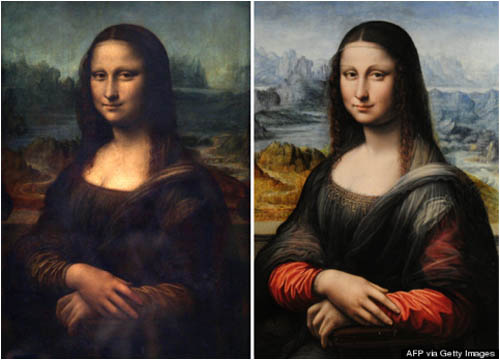
Well, it’s a lovely wishful thought … but, in a nutshell, I think not !
I’ve looked into this theory more than once myself in the past – the theory that some Renaissance artists understood the principle of stereoscopy, and applied it in their work to make stereoscopic pairs.
I think these researchers, are probably experienced art historians, but they’re very much NOT experienced stereoscopists. So Carbon and Hesslinger have managed to ‘find’ what they were very much hoping to find. When researchers do this, it’s often a time to look for warning lights flashing.
Let me explain.
Normal photography and paintings, in oils or watercolours, are both representations of the real world around us. They can both be quite successful (maybe that’s a slight understatement !) at doing this, but what they have in common is they are both attempts to recreate a three-dimensional scene on a flat surface, in just two dimensions. The dimension of depth is missing. Careful observation of the way subjects are lit can lend realism to paintings, and Renaissance painters DID discover the laws of perspective – how parallel lines can be made to converge on the canvas to imitate the appearance of disappearing toward the horizon just like in ‘real life’. This understanding was entirely lacking in paintings before the 15th century, and actually it took a long time even then before it was universally understood. Look at this great, maybe first, example in 1425 by Masolino da Panicale.
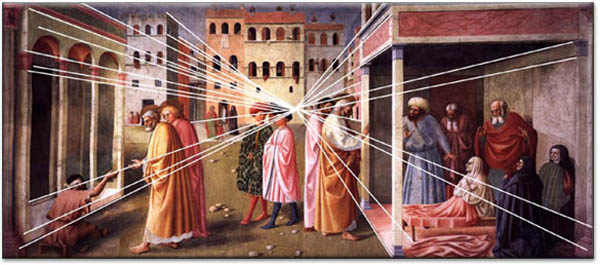
‘St. Peter Healing a Cripple and the Raising of Tabitha’ by Masolino da Panicale, 1425.
There’s a great article on all this here
www.webexhibits.org/sciartperspective/raphaelperspective1.html.
(NOT in Wiki, you’ll be pleased to hear, but by someone who clearly has researched the subject himself in great detail !) Brunelleschi is usually credited with the first clear insight into perspective, and certainly Raphael and Leonardo were completely familiar with the concept. But, even with all these insights, perspective drawings or paintings are still flat representations of in-depth scenes … they’re just better than non-perspective ones (though even then, there are plenty of painters who achieved realism of a different kind by deliberately ignoring perspective, Picasso among them). It’s interesting that photographs include all the lighting and perspective without us even trying. But they’re still flat !
So how can we truly capture a real three-dimensional scene in three dimensions ?
Leonardo is exactly the kind of wonderful lateral thinking man, immersed in art and science, who would could have figured that out. It would be lovely to think that he did, and it’s very understandable that these guys, Carbon and Hesslinger, would have got excited by the prospect. To discover whether he really did, we need to look carefully at what stereoscopy, otherwise known as 3-D photography, is.
3-D photography is based on a phenomenon called Stereopsis. Stereopsis happens in everyday life when our brain fuses two slightly dissimilar (flat) pictures from two slightly different viewpoints, one from each eye, and miraculously, instantaneously, creates a solid image in our heads. The two pictures are different because our eyes, positioned a few inches apart, see slightly different amounts of an object partially hidden behind another, and slightly different views of any solid object. These differences are called parallax. Our brains cleverly interpret these parallax differences as depth information. It’s happening all the time for most of us whenever our eyes are open, without any conscious thought. The benefits of this to our survival in a predatory world must have been enormous in the evolution of our species. It gave us an instant awareness of how close any potential danger (or food source) was to us.
Charles Wheatstone in 1832 had the amazing insight that a scene could be captured in three dimensions instead of just two, by getting photographs to recreate that miracle of stereopsis. For this purpose, Wheatstone brilliantly suggested, we just need two pictures instead of one. (It’s fascinating to note that when Wheatstone was having these thoughts, even ‘flat’ photography was not yet invented ! That was to follow very soon thanks to Niepcé, Daguerre and Fox-Talbot around 1838). But the trick is in how the two pictures are presented to our eyes. If two pictures are correctly presented separately, one to each of our eyes – pictures which recreate the views each of our eyes would have captured if we’d been at the scene – the stereopsis will happen.
Some of us are obsessed with all things stereoscopic, and spend thousands of hours in our lives studying historical stereo images. I’m one of them. It is surprising that nobody tumbled the workings of our two eyes until so recently in history. As a boy I was fascinated by how different the pictures from my two eyes sometimes were (for instance laying with one eye under the bedclothes !) and pretty soon I was drawing pairs of pictures at school that I could ‘free-view’ and fuse into 3-D pictures. But I was probably influenced by the 3-D cards that came with my Weetabix packets !
For us 3-D addicts, it’s quite obvious that these two versions of the famed ‘Mona Lisa’ are NOT a stereo pair, but it takes just a little more time to prove it.
The easiest place to start is the relationship of the background to the subject. If we were trying to create a 3-D image, even if we weren’t very good at figuring out the complexities of a human face, the first thing to deal with would be to make Mona Lisa stand out from the scenery behind. This requires the details of scenery to be just a little further to the right in the right image than the left. It takes no more than a moment to see that this is not the case here. The mountainous scenery is quite similar in the two versions on the left, and not so similar to the right. But if we look at these mountains closely we see that they are a lot lower in the left image than the right image (the red dots). The winding feature below in the background, on the other hand is higher in the left image. This means that we will never be able to fuse these two images and see Mona standing out in relief from the scenery behind her. There ARE horizontal differences too, but they are small, and in this assembly of the two images, in the wrong direction. To see this pair in any kind of 3-D, we’d have to be lying on our side and squinting, and swapping our eyes over for different bits of the image. Sorry … no chance.
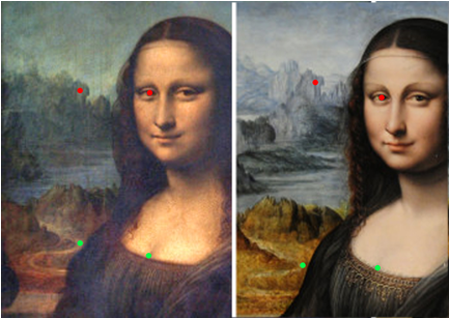
Vertical misalignment in corresponding details, between ‘left’ and ‘right’ images.
Just for comparison, here’s another piece of wishful thinking, so often quoted in histories of 3-D as an early example of three-dimensional imaging. They’re wrong ! It’s not ! Jacopo Chimenti da Empoli made these two sketches around 1600, and lots of people have sworn that this is a stereo pair. But, again, a little careful analysis shows that the variations between the positions of corresponding lines in the two pictures are in fact random, and you get just as much 3-D no matter which way round you position the two. Moreover an equal number of the supposed ‘parallax differences’ are vertical instead of horizontal, which makes nonsense of the assertion that Jacopo knew what stereoscopy was.
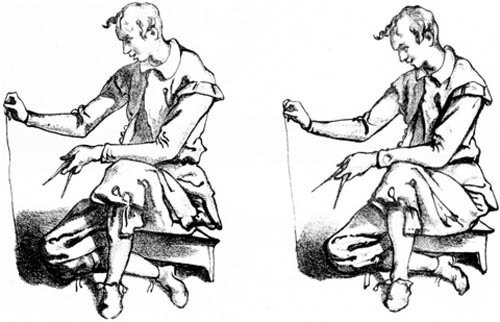
Chimenti’s drawings
As for assertions that Giovanni Battista della Porta (1538 (1535?)-1615), also understood binocular vision, if you’re interested, look at this great discussion by Abram Klooswyk:
www.stereoscopy.com/faq/history-errors.html
To sum up, as far as Renaissance 3-D paintings go, the truth of the matter seems to be that many artists created more than one version of their favourite scenes, sometimes painting in places quite far apart geographically, so they must have carried with them very detailed drawings which they were able to transfer to the surface they were working on. They were surprisingly accurate but there were of course some discrepancies between versions. It is these discrepancies, minor variations, that lead some people to think that they see a stereo image when fusing the two paintings. But, as we’ve seen, these variations are not consistent with any deliberate scheme of parallax. Sorry, guys, the 3-D image we all wanted to be there is simply not there.
There is a postscript. It is possible to paint in 3-D. Salvador Dali did it more than once, creating stereo pairs which work pretty well in the stereoscope. See my article on this, a long time ago, on Bri’s Soapbox. [February 2009]
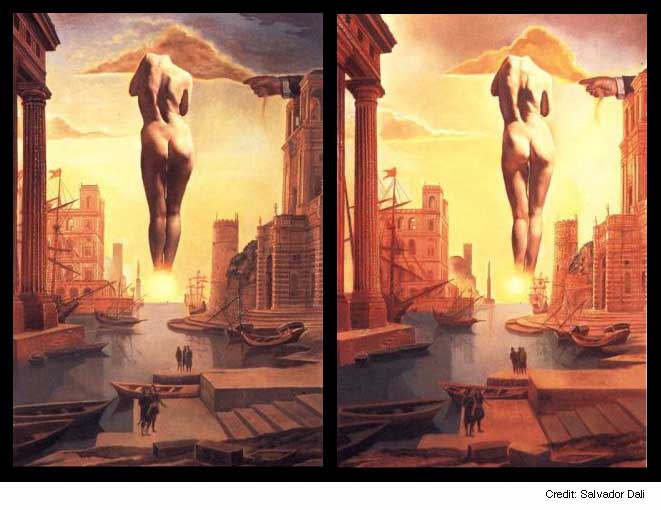
My conclusion, in spite of many attempts to dispute Charles Wheatstone’s originality (including, rather disgracefully, David Brewster in his day) is that the moment of genius in which mankind finally discovered what is now called “3-D” belongs entirely to Wheatstone. I doubt if any evidence will surface to seriously challenge that belief.
Bri
My only PPS would be ….
Now, after looking at the original article by Carbon and Hesslinger, I’m not at all sure that they ARE saying Leonardo was conscious of stereoscopy, as the Huff Post article claims !! they seem to be more concerned as to whether the background was painted from life or copied from a canvas ! Curiouser and curiouser !
Bri
—
Don Richard wrote:
Date: 4 May 2014
What do you think of this Brian? Would be interested in your view on this?
Thanks,
Don Richard
HUFFINGTON POST
05/03/2014
The ‘Mona Lisa’ Just Might Be Part Of History’s First 3D Image, Researchers Claim
The Huffington Post | by Katherine Brooks
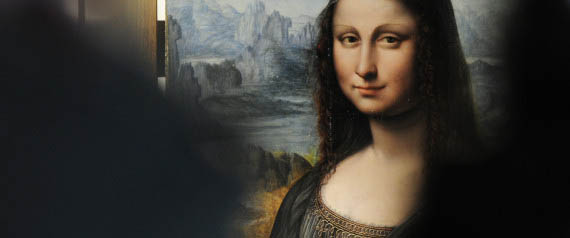
Leonard da Vinci was the original Renaissance man, dabbling in not just art, but anatomy, geology, botany, cartography, mathematics, literature and much, much more. Not only do we give him credit for masterpieces like “The Last Supper” and “The Vitruvian Man,” history praises his work in musical instrument construction, hydraulics, cannon design and early flying machines.
So it wouldn’t hurt, we suppose, to credit the man with 3D imagery too.
It’s a claim German researchers Claus-Christian Carbon and Vera Hesslinger assert in their study of Leonardo’s famous portrait, “Mona Lisa.” The pair have been analyzing the well-known version of La Giaconda that hangs at Paris’ Louvre, as well as an eerily similar copy known as the “Prado Mona Lisa,” housed at the Museo del Prado in Spain, and have concluded that the two artworks — taken together — may amount to the first stereoscopic image in the world.
In other words, our first 3D artwork.

Carbon and Hesslinger base their theory on side-by-side comparisons of “Mona Lisa” and her Prado counterpart — a painting introduced to the public back in 2012 as the possible work of Le
onardo or one of his students. They claim that there is a slight perspective shift between the two works, meaning that the portraits were painted from separate vantage points.
“When I first perceived the two paintings side by side, it was very obvious for me that there is a very small but evident difference in perspectives,” Carbon, of the University of Hamburg in Germany, wrote in an email to Live Science.
“This is particularly clear if you observe the chair on which La Gioconda sits: In the Prado version, you can still see the end of the end corner of the chair at the background of the painting, which you cannot see in the Louvre version, because the painter of the Prado version looked at the ‘Mona Lisa’ more from the left than the painter of the Louvre version.”
Intrigued, Carbon and Hesslinger decided to calculate the positions the painter (or painters) would have taken to create each “Mona Lisa” version. They found that the horizontal difference between the two paintings was about 2.7 inches, which happens to be very close to the average distance between a person’s eyes.
Here’s where the researchers take their leap into 3D hypotheses. Each of our eyes perceive objects at different perspectives, sending two separate, flat images to our brain to be translated into one three-dimensional representation. That is the image we “see.”
Similarly, Carbon and Hesslinger surmise that the two perspectives used in the Louvre and Prado “Mona Lisas” could amount to one 3D image. Place the visual information together, and you have a stereoscopic masterpiece.
They’ve used a red–cyan anaglyph to combine the two portraits — namely, the area depicting La Giaconda’s hands — and the result is like gazing upon Leonardo’s mysterious woman without 3D glasses. Essentially, there’s depth. But it’s impossible to know whether Carbon and Hesslinger’s observations are coincidental, or if Leonardo intentionally created the first stereoscopic art.
“DaVinci did write about monocular and binocular vision, and studied aspects of optics including eye anatomy and light reflection, and he even experimented with colored light sources,” Science News’ Erika Engelhaupt writes. “But it’s not clear whether he put all the pieces together to understand how to create a stereoscopic image. The paintings don’t quite make a perfect stereo pair.”
You can read Carbon and Hesslinger’s entire study here. Let us know your thoughts on Leonardo’s 3D aspirations in the comments.
h/t NBC News
PLEASE OBSERVE COPYRIGHT
© brianmay.com